Diving Moorea
Moorea, Society
Islands, French Polynesia
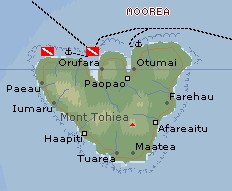
Click on the map to go to the general Society Islands page |
Moorea was one of our favorite dive locations. The combination of the
majestic grandeur of the hills towering above us, the clear water around us, and
the isolation made for idyllic conditions. Our usual anchorage was just to
the left (west) of the Ray Corridor label at about
17° 29.2'S, 149° 52.7'W (see the
map below, which shows the north coast of Moorea and the entrance to Opunohu
Bay). Since we spent time there with both
Karen & Jon, and
Vince (all divers) we did
several dives, some of them more than once. In all, we dove at 5 different
locations (and snorkeled many more), all along the north coast: the
Canyons by Opunohu Pass, the
Small Rose Garden & Coral Wall,
and Taotoi (all outside the reef) and
Stingray World and
Ray Corridor inside the reef.
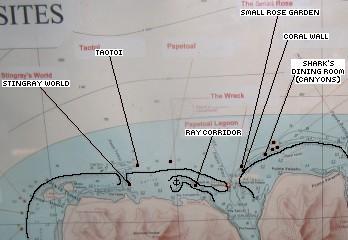
NW corner of Moorea, with our dive sites and anchorage marked.
Beachcomber resort is just opposite the Stingray World dive. |
Air Fills: Most dive shops in French Polynesia
charge 1000 CFP (about US$11) per bottle to fill, but the new management at the
Beachcomber Hotel Dive Center (opposite the Taotoi entrance) filled our tanks for half that.
Whether it was a goodwill gesture, or will be an ongoing practice, we don't
know, but we were sure grateful.
Positions: We've now added latitude and
longitude positions to our dive tables. We did not take a GPS with us -
these positions were determined afterwards from our navigation charts.
They're as accurate as we can make them, but they should not be depended on too
much.
Fresh Water: We found free fresh water on the small dock
in front of the orange-roofed church on the western side of Opunohu Bay. Also,
because we filled our tanks at the Beachcomber, they were happy to have us use
their showers and dunk tank, which were accessible by dinghy.
|
Canyons by Opunohu Pass |
Type: |
Outer reef canyons dive |
Access: |
Dinghy / dive boat moorings |
|
Position: |
17° 29.1'S, 149° 51.1'W |
Depths: |
35-65' (11-20m), no bottom |
Date: |
February, 2004 |
Visibility: |
80' (25m) |
Dive shop: |
Yes. |
Snorkeling: |
No, too much surge and too deep. |
Features: |
Sharks. Occasional strong current. |
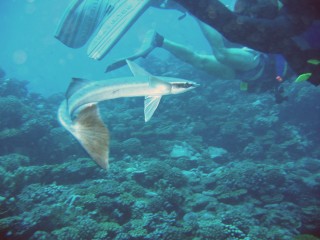
Persistent sharksuckers try to latch onto divers |
(Jon) The mooring we used for this dive is one of those on the
map above labeled as Sharks' Dining Room. I actually did this dive twice,
once with Vince and Chris,
and once with Karen & Jon
and Sue. Neither dive was free of troubles. With Vince and Chris,
our dive plan was to go up-current first, then turn around at 1,500 psi (100 atm) and drift
back to the dinghy. This is a prudent and normal plan for us, but when we
got to the bottom there was little current and several other divers in that
direction, so we headed NE first. When we turned around we also (as we
usually do) came up a few dozen feet. This put us closer to the reef,
where we discovered that there was a bit of current (now against us) as
well as some significant surge. I didn't realize that Chris was having problems
keeping up and that he was burning through his air too quickly, which I should have.
With Karen and Jon and Sue, I realized that it was pretty
easy to lose track of where the dinghy was, so I was counting the canyons as we
went over them. We turned around after about 8 canyons and I counted down
as we came back. But it's difficult to keep track when there's so much
interesting stuff to see. After 8 canyons there was still no dinghy.
I thought I'd just mis-counted, so we continued on. After several more
canyons and still no dinghy, I was down to only 500 psi (33 atm) and
decided to surface. After several minutes looking, I finally spotted the
dinghy several hundred yards back behind us, up current. This is where I
learned that it's often easier swimming 10' below the surface than swimming on
the surface encumbered with scuba paraphernalia.
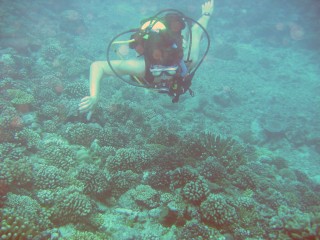
Vince swimming over a garden of coral. |
That said, the dives were still interesting. The bottom
is a series of valleys, perhaps 20-30' deep, with different fish and corals on the
"ridges" and in the valleys. It was good fun
"flying" over these ridges and valleys. Sometimes these valleys would have
different currents in the bottom of them. As with all outer-reef dives in
Moorea, there were lots of sharks, usually 4-6 visible at any one
time. Most of these were the common 4-6 foot Black-tipped Reef Sharks, but
I also saw a 6-8' Grey Shark with a remora under its jaw, as well as another
shark I couldn't identify, possibly a Lemon Shark. Very cool (but it does
get the old ticker pumping...).
(Chris) This dive certainly started out well. We (Vince, my dad, and I)
dinghied to a mooring out past Opunohu Pass. Once we were down there was some discussion
(tricky underwater, since you have to use hand signals) about which way the
current was going (I'm not sure we got it quite right). Anyhow, we started off
essentially upstream, going up and down as we passed over ridges, and watching
the small (4-5 foot) reef sharks that swam randomly around us.
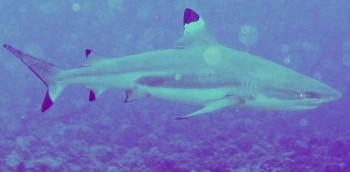
One of several black-tipped reef sharks.
We tried to ignore them, as the reef fish did. |
When we reached the halfway point on our air supply, we
decided to turn around and head back. Before we did, I got a shot of a really
nice grey shark that watched us from 30-40 feet away (a comfortable distance for
a 7-foot shark). Unfortunately, the flash didn't work that far away, and the
picture didn't come out well. Still, it was exciting to see a shark bigger than
a blacktip. Unfortunately, on the trip back the current was definitely against
us, and there was some surge (back-and-forward motion) as well. I was having fin
problems (getting my feet rubbed raw because I haven't yet found any fins that fit
perfectly) and fell behind the group. Vince eventually spotted me (maybe heard
my tank banger) and dropped back, but my dad kept going. At this point I was
starting to over-breathe my regulator (you can only draw air so fast through a reg) so
I slowed down and started to surface. Vince and then my dad surfaced
also, and a passing dive boat picked us up and took us back to our dinghy.
(Sue)
We were happy to find that although the dive operators in Moorea feed the sharks,
we were not mobbed by hungry sharks when we dove without food for them! They did
swim lazily with us and near us, though, which was wonderful.
The most unnerving fish were the sharksuckers who wanted to hitch free rides on us,
the divers. We were constantly shoeing them off. Karen, in full wetsuit, never
felt them. But those of us with exposed legs sometimes felt the creepy brush and
suck of a 2- or 3-foot sharksucker. (See above)
Small Rose Garden & Coral Wall |
Type: |
Outer-reef / wall dive |
Access: |
Dinghy / dive boat moorings |
|
Position: |
17° 28.2'S, 149° 51.1'W |
Depth: |
45-70' (13-21m), no bottom |
Date: |
February, 2004 |
Visibility: |
80' (25m) |
Dive shop: |
Yes. |
Snorkeling: |
No, too much surge and too deep |
Features: |
Sharks & remoras (shark-suckers) |
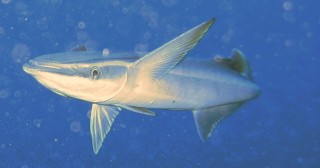
The strange shape of a sharksucker becomes a familiar sight off Moorea. |
(Jon) This was a nice dive that I did with
Karen & Jon. We
tied the dinghy to the 2nd mooring from
the mouth of Opunohu Bay, set ourselves up and drifted to the bottom in 45'
(13m). There were lots of 4-6' black-tipped reef sharks, and even more sharksuckers (like
remora's). We always had at least 7 sharks in view at
any time, slowly cruising in circles. Although there were lots of fish all
around us, they paid very little attention to the sharks. We tried to do
the same.
In the end we called this dive the "Remora
Dive" because 3 of them followed us everywhere we went, trying to attach to our
legs or our tanks. Strangely, I had difficulty photographing these sharksuckers,
mostly because their skin is unusually shiny and they were so close!
Taotoi |
Type: |
Outer-reef wall/canyon dive |
Access: |
Dinghy/dive boat moorings (2) |
|
Position: |
17° 28.9'S, 149° 53.4'W |
Depths: |
35-60' (11-18m), no bottom |
Date: |
February, 2004 |
Visibility: |
100 feet (30m) |
Dive shop: |
Yes. |
Snorkeling: |
No, too deep, and too much surge. |
Features: |
Strong surge, some current. Sharks.
Jojo the Napoleon wrasse and a big moray eel. |
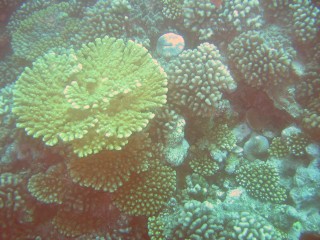
Beautiful coral formations were everywhere |
(Jon)
This was one of our favorite dives. I actually did this dive twice, both
times with Karen & Jon,
and once each with Sue and Chris. Getting to this site (just outside and
east of the narrow Taotoi Pass) is an interesting proposition, as the pass is
fairly shallow, leading to a considerable rip-tide, big swells and occasional
breakers. The dinghy (named, incidentally, Tomcat) and the crew got
quite a workout.
We splashed into 35' (11m) with me going down slowly because
my right ear was having problems adjusting to the pressure changes. We
found a considerable current, so we started going up current, over the now
familiar hills and valleys of Moorea's outer reef. The first wall, just
next to the mooring, had a nice overhang, filled with big-eyed squirrelfish.
We started out with a constant swarm of blue-striped snapper swimming with us,
possibly looking for a handout. We also always had 6-7 black-tipped reef
sharks in view at any time, but we were getting used to that by now. We
also saw several big triggerfish, but none attacked us as they did in
Tahiti.
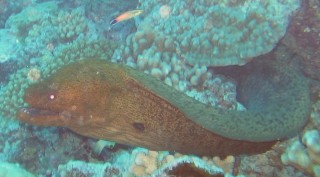
A 6-foot giant moray eel lives near the mooring and often comes out to greet the divers |
We swam our standard pattern of going up-current until we
were down to about 1,500 psi (100 atm) and then turning around and coming up a bit so
we got some new scenery. The strong current brought us back to Tomcat
quickly, so we looked around the overhang a bit more. We'd heard there was
a big moray eel in the area and he eventually graced us with his presence.
We tried to feed him some bread we'd bought in a zip-lock bag, but the snappers
snapped it up long before the shy moray could get any. We also saw Jojo,
the big napoleon wrasse at the very end, as I was doing my safety stop on the
mooring line. Very cool!
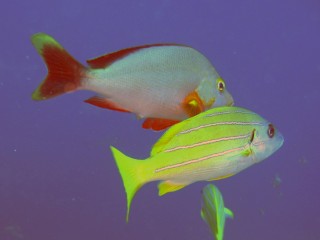
Bright, colorful fish swam close by! |
(Sue)
Got the bottles filled at Bathy's and headed out in the morning. The pass was very
rough, with winds from the northeast causing the seas to curl and almost
break...not fun in the dinghy. But once we were on the mooring, suited up, and
splashed into the calm, quiet blue, all was well. There were 6 or 7 blacktipped
reef sharks about, but they ignored us. A moderate current was running to the
west, so we swam east till we were all about down to 1200 psi. We crossed
numerous coral shelves and valleys, always accompanied by blue lined snappers.
There was a fairly defined drop-off to the north, so it was easy to navigate and
return to the mooring. One valley west of the mooring is where the resident 6-foot moray
hangs out. He did appear from his reef to check us out. While doing safety stops
on the mooring line we also got a visit from Jojo the hump-head (Napoleon) wrasse.
(Chris) Talk about beautiful dives! We saw so many fish and corals
that I didn't even realize we never saw the eel or wrasse until we were back in
the dinghy. Even as we descended, there was a blacktip shark watching us and
several fish swimming around the mooring. We swam over gentle ridges and valleys
against a very light current, then turned around and saw new stuff coming back.
I do wish we'd seen Jojo or the giant moray, but even without them it was a good
dive.
Stingray World |
Type: |
Lagoon dive |
Access: |
Dinghy / dive boat mooring |
|
Position: |
17° 29.3'S, 149° 53.6'W |
Depths: |
20-60' (6-18m) |
Date: |
February, 2004 |
Visibility: |
40' (12m) |
Dive shop: |
Yes. |
Snorkeling: |
Yes, but visibility was poor. |
Features: |
Tahitian stingrays and spotted eagle rays.
Occasional strong outward current. |
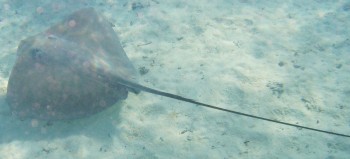
A Tahitian stingray scavenges for food.
Click the image to see his stinger. |
(Jon)
This is inside the Moorea reef, in a sand-bottomed area just inside the Taotoi Pass, near the
Beachcomber Hotel. It doesn't look like much because it's wading depth
just next to the mooring. My main purpose in this dive was to get Amanda
back into scuba diving after her somewhat scary high-current dive off the
St. Etienne Drop-Off in Tahiti.
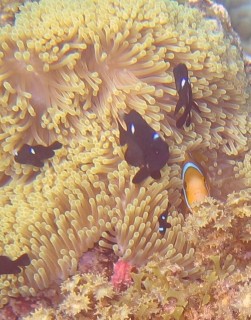
Three-spot Dascyllus and
Anemone Fish live within the
tentacles of the sea anemone. |
We splashed into 20' (6m) with a sand bottom, but it soon got
deeper. The visibility was not very good (by Society Island standards) but
it was good enough. I wanted to avoid the strong currents that suck the
lagoon water out the Taotoi Pass so we traversed across the face until we ran
into some fairly strong currents and then we turned back at a different depth so
we could see different things. We got back to the mooring with plenty of
air but there's nowhere else to go so we did it again, taking more time to
explore the rock cliffs.
We did see a flight of 7 Spotted Eagle Rays, but they
weren't very close. We saw several other fish and I actually got some nice
photos, despite the sediment in the water. Back on Ocelot, we engaged in
our normal (and delightful) pastime of sorting through the pictures, trying to
identify the many fish we'd seen.
(Amanda)
I was a bit dubious about this dive, as the last one I had done
(St. Etienne, in Tahiti) my BCD
wouldn't release air and I didn't have enough weights, so it was hard to stay
down above about 30 feet. But my mom had had the same problem, and she said it
was better with the spill-pull (which I hadn't known where it was) and an extra
kilo. With so many people cajoling me and asking me to dive, I slipped another
weight into a pocket and *splash*
The dive was okay,
but because of the current we could only go so far along the wall, so we went
back and forth twice. It was rather murky, definitely not the sort of visibility
we've had other places. A lot of the coral was silt-covered, but we did see a
few anemones and their anemone fish, schools of Yellow-fin Snappers that
we could literally reach out and touch, and of course several spotted eagle rays
and Tahitian stingrays paid a visit. Close-looking revealed about five leopard
flounders, as well. |
Ray Corridor |
Type: |
Lagoon dive in channel |
Access: |
Dinghy moorings located between navigation buoys. |
|
Position: |
17° 29.3'S, 149° 52.5'W |
Depth: |
10-65' (3-20m) |
Date: |
February, 2004 |
Visibility: |
40 feet (12m) |
Dive shop: |
Yes. |
Snorkeling: |
Yes, all along sides of channel, but best at slack water. |
Features: |
Spotted eagle rays. Some current in channel. |
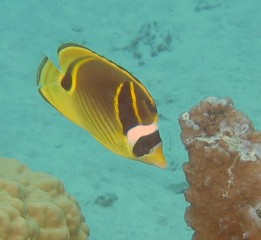
Raccoon Butterflyfish are distinctive with their black masks. |
(Jon)
Ray Corridor has some fairly high currents (as do most
dives inside the barrier reef) and the visibility is not as good as the outside
dives (ditto) but it's an easy and fun dive. The start is just east of
where Ocelot anchored, making it very easy to get to. This was our second
dive of the day, and the dive-shop was slow filling our tanks, so we only
started about 4pm, a bit later than we like as the low light makes photography
difficult. The dive starts in only 10' (3m) but soon gets deeper. We
dove our now standard pattern of swimming up current initially until we had used
about half of our air, and then turning around and letting the current push us
along back to the mooring.
The part I liked most about this dive is that much of it was
along the wall at the edge of the boat channel. Wall diving is fun because
you can choose your depth and then change it coming back, seeing completely new
fish and coral. I went deeper than most folks, trying to get different
photos by shooting up at the fish, a trick I'd just learned from
professional photographer Rod Klein, whom we'd just met at the dive shop.
I was also looking for holes and ledges that the fish might be hiding under.
We did actually see a flight of 7 Spotted Eagle Rays, and later a lone ray
heading the other direction, most of our photos were of other, smaller fish.
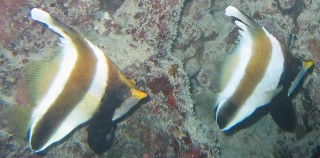
Pennant Bannerfish swimming in tandem. |
(Sue) Because this site is near the Opunohu Pass we had to deal with
strong current pulling us towards the pass. Luckily we found eddies of calmer
water behind the curves of the coral wall. One dive challenge I had not
anticipated was the trick of being partner to a photographer. Jon, of course,
was off following fish, or poking his camera into little nooks and crannies
while I tried to hover nearby, but not so close that I disturbed the fish.
Sometimes other divers we were with had other agendas, so we ended up farther
apart than I liked. In retrospect, a photography pair should probably be
independent of other divers if safety conditions allow. Although visibility was
not great (just what the rays like!) we did see many small fish species.
Up | Diving Bonaire | Diving Tahanea | Diving Fakarava | Diving Toau | Diving Tahiti | Diving Moorea | Tonga (commercial) | Tonga (private) | Diving Fiji | Diving Indonesia | Diving Thailand | Diving Maldives
Reef Animals | UW Photo How-to | Scuba Diving
| Moorea Home
Top Level:
Home |
Destinations |
Cruising Info |
Underwater |
Boat Guests |
Ocelot |
Sue |
Jon |
Amanda |
Chris |
Site Map |
Make a Comment
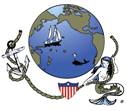 |
Lifetime
Commodores
of the
Seven Seas
Cruising
Association |
 |
|
If our information is useful,
you can help by making a donation
|
Copyright © 2000‑ Contact:
Jon and Sue Hacking -- HackingFamily.com, svOcelot.com.
All rights reserved.














